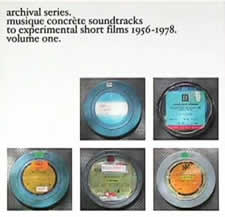Archival Series Volume One
- title
Archival Series Volume One
- label
The New England Electric Music Company
- format
- various artists 3inch CD
 Subtitled 'Musique Concrete Soundtracks to Experimental Short Films 1956-1978.' Artists on the CD are Tom Dissevelt, Gershon Kingsley, Percy Grainger, Pierre Boulez, Joan LaBarbara. Volume One of the archival series of three 3inch CDs put out by the New England Electric Music Company, is by far the most varied of the three Archive series that I have heard so far. There are 4 much shorter tracks - but also there is the most tension conveyed.
Subtitled 'Musique Concrete Soundtracks to Experimental Short Films 1956-1978.' Artists on the CD are Tom Dissevelt, Gershon Kingsley, Percy Grainger, Pierre Boulez, Joan LaBarbara. Volume One of the archival series of three 3inch CDs put out by the New England Electric Music Company, is by far the most varied of the three Archive series that I have heard so far. There are 4 much shorter tracks - but also there is the most tension conveyed.
- Tom Dissevelt Glass 1958 (Dir: Bert Haanstra) Track one is brief - with spoken words in a foreign language and whistles/clapping/breaking glass echoed - there is a lot going on. The rhythm and feel reminds me of Throbbing Gristle or Jean-Jacques Perrey. Fittingly, the film is a ducument on manual and automated glass- moulding techniques.
- Gershon Kingsley Pixillation 1971 - (Dir: Lillian Schwartz & Ken Knowlton for Bell Labs) 1971, 4 minutes, colour, 16mm
Track two is a pulsing and rhythmic bass line/drum track which slowly builds up - probably the closest to 'music' on the disc. There are even keyboards in the latter half playing scattered melodies taking over as the pulsing bass notes tend to fall apart. When the bubbling electronics start we know we are into the complete mayhem. This reminds me of Can at their best. Gershon 'Popcorn' Kingsley is known for his moog sounds. - Percy Grainger Free Music 1970 - (Dir Unknown) Track three comes as a relief after so much tension in the previous track- it is brief, sounding like outer space walkie talkies or radio waves - the voice over adds a moon-like interest to it. Apparently this piece is taken from a TV show reporting on Percy Grainger's involvement with free music machines, which is a machine used to play a music not limited by time or pitch intervals and which were considered as an early example of modern electronic synthesisers.
- Pierre Boulez Symphonie Mechanique 1956 (Dir: Jean Mitry)
Track four sounds garbled and jumpy and is quite playful for Boulez who is more known for his 'tonal serialism' than for musique concrete. This is the longest track here at almost 8 minutes. The film uses choregraphed machinery, gears and levers. - Joan LaBarbara Dance Frame 1978 (Dir: Doris Chase) Unusual for Joan LaBarbara, who is more known for her vocal prowess and composition, track 5 represents her foray into electronic noise and is quite exciting to hear.
All in all, I think Volume one of this series is my favorite, thanks to the variety and the number of tracks included. These would sound great on any NCP show, or even inbetween songs on your rock show if you want something a little more interesting to segue between rock tracks.